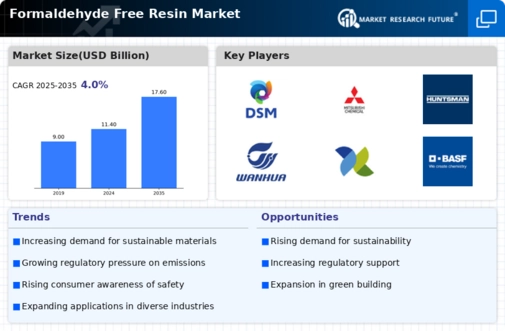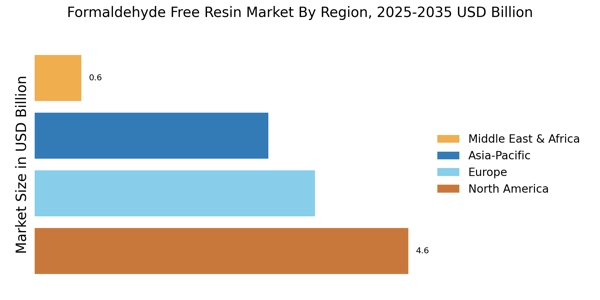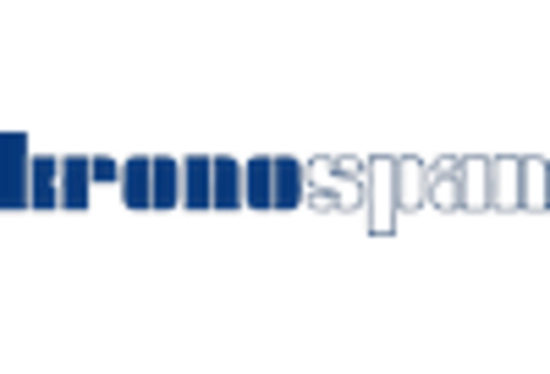Consumer Awareness
The growing awareness among consumers regarding health and safety issues is emerging as a significant driver for the Formaldehyde Free Resin Market. As individuals become more informed about the potential health risks associated with formaldehyde exposure, there is a noticeable shift towards products that are labeled as formaldehyde-free. This trend is particularly evident in the home furnishings and building materials sectors, where consumers are increasingly prioritizing indoor air quality and overall well-being. Market data indicates that products marketed as formaldehyde-free are witnessing higher demand, as consumers actively seek safer alternatives for their homes and workplaces. This heightened awareness is prompting manufacturers to highlight the benefits of formaldehyde-free resins in their marketing strategies, thereby further propelling market growth. The consumer-driven demand for safer products is likely to continue influencing the industry in the foreseeable future.
Regulatory Compliance
Regulatory frameworks are significantly influencing the Formaldehyde Free Resin Market. Governments and regulatory bodies are implementing stricter guidelines regarding the use of formaldehyde in various applications, particularly in the construction and furniture sectors. These regulations are aimed at reducing health risks associated with formaldehyde exposure, thereby driving the demand for formaldehyde-free alternatives. As a result, manufacturers are compelled to adapt their product offerings to comply with these regulations, which is likely to boost the market for formaldehyde-free resins. Recent data suggests that regions with stringent environmental regulations are experiencing a faster transition towards formaldehyde-free products, as companies seek to avoid penalties and enhance their market reputation. This regulatory pressure is expected to continue shaping the industry landscape, encouraging innovation and investment in safer resin technologies.
Technological Innovations
Technological advancements are playing a crucial role in shaping the Formaldehyde Free Resin Market. Innovations in resin formulation and production processes have led to the development of high-performance alternatives that meet stringent quality standards. For instance, advancements in bio-based resins and polymer chemistry are enabling manufacturers to produce formaldehyde-free options that exhibit superior durability and performance characteristics. The market is witnessing a surge in the introduction of new products that cater to diverse applications, from automotive to consumer goods. Data indicates that the adoption of advanced manufacturing techniques is expected to enhance production efficiency and reduce costs, thereby making formaldehyde-free resins more accessible to a broader range of industries. This technological evolution not only supports market growth but also aligns with the increasing demand for safer and more sustainable materials.
Sustainability Initiatives
The increasing emphasis on sustainability appears to be a primary driver for the Formaldehyde Free Resin Market. As consumers and manufacturers alike become more environmentally conscious, the demand for eco-friendly materials is rising. This shift is evident in various sectors, including construction and furniture, where formaldehyde-free resins are preferred due to their lower environmental impact. According to recent data, the market for sustainable materials is projected to grow significantly, with formaldehyde-free options gaining traction. Companies are investing in research and development to create innovative products that align with sustainability goals, thereby enhancing their market position. The trend towards green building practices further supports the adoption of formaldehyde-free resins, as they contribute to healthier indoor air quality and reduced emissions.
Market Expansion Opportunities
The Formaldehyde Free Resin Market is currently experiencing various expansion opportunities across multiple sectors. As industries increasingly recognize the benefits of formaldehyde-free alternatives, there is a growing potential for market penetration in emerging economies. These regions are witnessing rapid industrialization and urbanization, leading to increased demand for construction materials and consumer goods. Market data suggests that the adoption of formaldehyde-free resins in these areas is likely to accelerate, driven by both regulatory pressures and consumer preferences. Additionally, the rise of green building initiatives and sustainable manufacturing practices is creating new avenues for growth. Companies that strategically position themselves to capitalize on these opportunities may find themselves at a competitive advantage, as the market for formaldehyde-free resins continues to evolve and expand.


















Leave a Comment